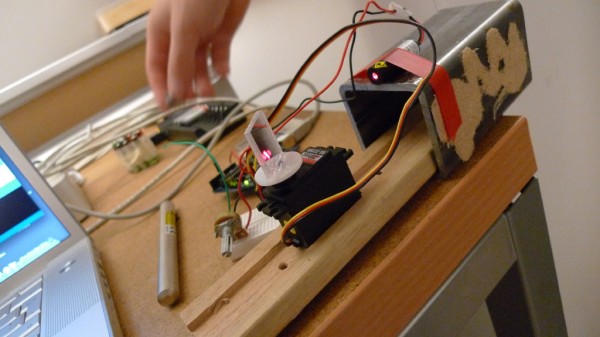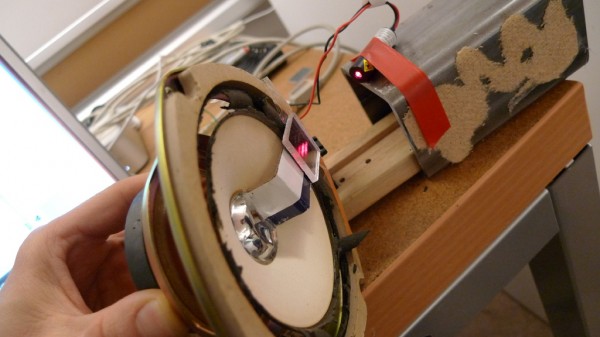Using sound for actuation
Sound and touch are very close in many ways: one can literally feels audio if the parameters are right. As presented by Roope Takala (Nokia Research), stimuli from audio and haptic overlap a great deal between 100 and 2000 Hz.
Today I was helping a first year student to build a little x-y laser scanner quickly and cheaply. We tried with RC servos and stepper motor, but the scanning motion was not good (fast) enough for our needs. We could see the laser dot moving from left to right, not a solid bar we wanted to have.
Remembering some projects I’ve seen in audio visualization, I decided to try with a speaker to see what kind of actuation we could get directly out of sound. I took an old speaker lying around in the workshop and mounted a little mirror on it using a piece of L-shape cardboard. Amazingly, this contraption worked perfectly. The laser beam was spreading evenly and fast enough so the source was indiscernible . We tried with different songs (Daft Punk) and with our own loops in Garage Band, with varying results, but all very satisfying.
I don’t know what kind of frequency we were getting on the mirror, going from the audio signal to the actual half broken speaker cone and support moving in the physical world. It feels that we are getting a couple of thousand Hertz at least.
The takeaway from this little tinkering session is that audio can be a very good source of movement or actuation. The amplitude is generally limited to 1cm or so (on common size speaker cone). As expected, specific discreet and sustained position might be difficult to obtain, but for fast and repetitive output it can be quite good and dead simple to use. The output is and feels “analog”, even if the input has sharp and digital-like qualities.
One of the great thing about using audio is that the elaboration of the signal is directly audible (and sometime enjoyable). You can “hear” the movement in a way. I think this is a very good thing as scripting/programming actuated output can be often very abstract and intangible. It can be a distraction too, as it is quite difficult to cancel the audible part from the movement.
Anyways, I like the idea of using one modality to control another. And the transition between the two is not well defined. The modalities blend into each other and the qualities are ported to the other. I will definitely explore this area further in the coming weeks and months.



Comments are closed.